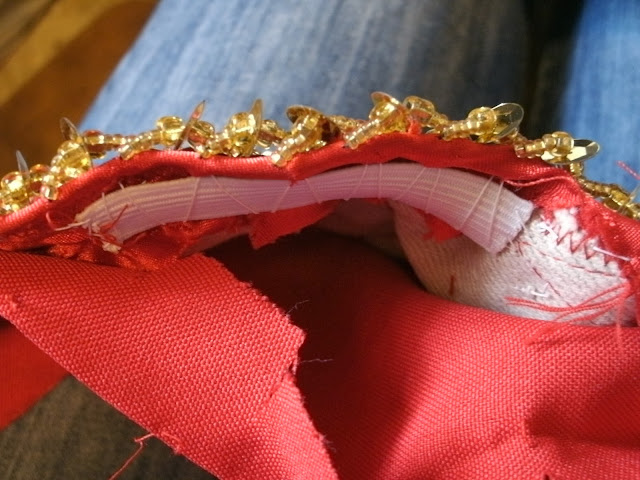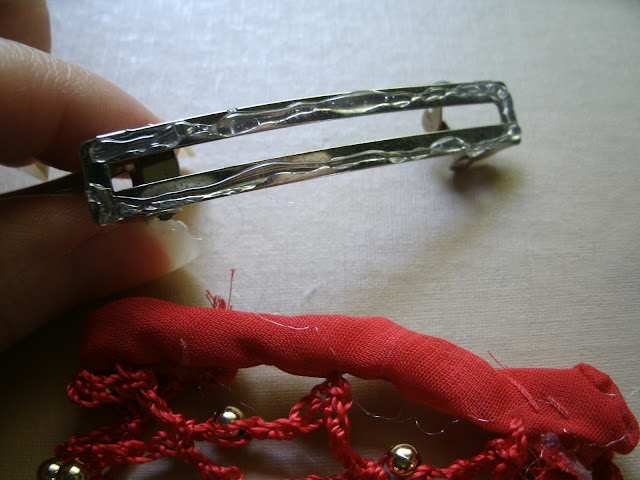Careful you don't trip and fall in.
I first saw the technique of using elastic to smooth away gaps in belts published in Dahlal's costume catalog, Inside the Harem. Being without imagination and a total costume newb at the time, I thought it was the best thing since sliced bread. I needed to get rid of a butt-gap on my red coin belt so I decided to show the detailed process here.
You can sew the elastic under the belt lining or right on top of it. I've done it both ways with the same results. Here I decided to put the elastic under the lining because I had the time open it up, sew in elastic, and re-close the lining. Not that it's terribly time consuming. I probably finished the whole thing in 20 minutes. But, if you are squeamish about ripping open the lining, just skip that part and go right into sewing on the elastic.
Keep in mind adding elastic won't fix every belt gap. If you have a
multiple or very wide gaps, have a unique figure, or if the belt is just
designed funky you may need a major alteration such as cutting and
removing parts of the belt or adding darts. But for those pesky 1 inch or so gaps this seems to do the trick.
You will need:
- Small length of elastic
- Sturdy thread
- Safety pin
- Sewing needle
- Scissors
- Seam ripper (optional)
- Fire (optional)
There are no rules as to how much elastic you need. I used two 3 inch-ish pieces. Two because my belt has a heart shaped curve along the back and it was easier to put a piece on each side instead of trying to curve the elastic. If the belt was straight I would have used one piece of elastic centered in the middle back between 4-5 inches long. The type of elastic really does not matter here either. I used a scrap piece I had in my stash.
- Seam rip the lining (optional,) along the area of the gap.
- Use a lighter or candle flame to singe the ends of the elastic to minimize fraying (optional.)
- Anchor one end of the elastic to the inside layers (or lining) of the belt with your choice of stitch close to the upper edge of the belt. Do not stitch all the way through to the front of the belt. Make sure the elastic is secure by giving it a couple of tugs before moving on.
- Stretch the elastic and inch or so longer then when it is at rest and safety pin it to the belt. When you stretch the elastic out it should lay flat against the belt. When you let go it should make the belt pucker along the edge. I prefer using safety pins here over regular pins because they will not slip out and I cannot stab myself on them.
- Begin zig-zagging stitches back and forth over the top of the elastic but not through it, stitching only through the inner layers of the belt and not all the way through to the front. This will create a casing for the elastic so it will not slide around but will still be able to stretch. Keep the stitches loose. Stretch the elastic out flush against the belt every few stitches to ensure the stitches are not constricting its movement.
- Stitch down the remaining end of elastic then remove the safety pin. NOTE: I wanted to do it all with one long piece of thread so I stitched one side, zig-zagged across, and then stitched the other side in one pass without starting and stopping. You can stitch down both sides of the elastic first and then add the zig-zag casing across the top if that works better for you.
- If you put the elastic on top of the lining then you are done. Good Job! To replace the lining keep reading.
Second piece of elastic added.
- To close the lining, begin your first stitch 3-4 stitches back from the open edge of the lining and sew right over the top of the original stitches.
- When you get to the last original stitch continue sewing to close the hole you have made.
- Once you have closed the hole continue sewing over 3-4 of the original stitches on the other side.
- Knot and cut your thread.
Crack is wack.
The belt should now lay smoothly against your body instead of gaping around the curve of your back. You can add elastic to trouble spots on a spandex or velvet skirt in the same manner. This trick is also handy for taming bulkiness along the side straps of your bra underneath the armpit area.
Have fun and good luck!
~N























































